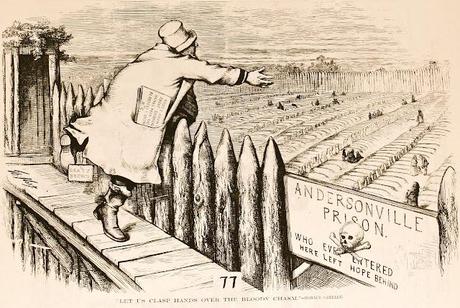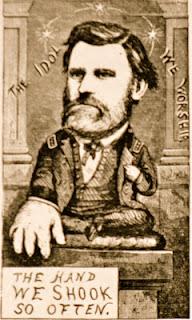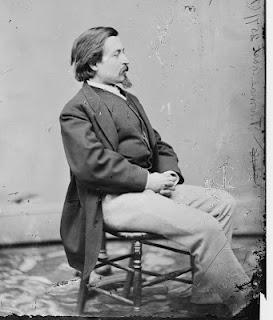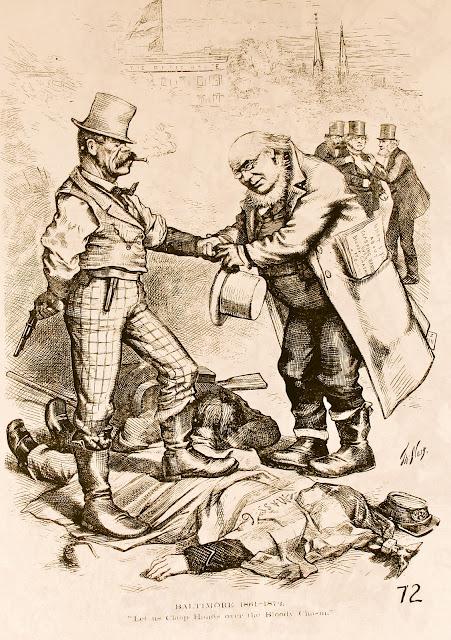
Horace Greeley, pictured by Nast as as an out-of-touch nitwit in oversized coat and hat, oblivious to the sea of dead Union solidiers at notorious Andersonville Prison as he tries to and reconcile with the South. The scrap of paper in his pocket reads "What I know about sharing hands over the bloodiest chasms, by H.G." Harpers Weekly, September 21, 1872.
Yes, we've seen presidential campaigns get pretty nasty, with the 2004 "Swift Boat" ads turning John Kerry, a decorated war hero, into a virtual traitor, probably representing the low point of recent years. Negative campaigns have been a staple in America since the days of Thomas Jefferson and Abraham Lincoln. So, looking forward to the finale of 2012, how low can it go? Hold on to your seats....

Nast's fawning view of Grant from
an 1866 Harper's Weekly cartoon.
The irony, of course, was that Greeley had been an original founder of the Republican Party in 1856, an early abolitionist and harsh critic of rebels during the War, but he bolted in 1872 in over Grant-era scandals, Grant's reconstruction policy against the South, and Greeley's own unique combination of vanity and ambition.

Thomas Nast, circa 1870.
Thomas Nast adored Ulysses Grant, considered him a national hero for winning the Civil War, and detested anyone who questioned Grant's honest. By 1872, Nast's fame over helping to topple Boss Tweed had given him an enormous national following. Senators, Congressmen, and Presidents all courted him, knowing that literally a million Americans could be swayed by a single Nast cartoon.For Nast, Greeley made an easy target. Just seven years after the Civil War, resentments ran deep. They called it "waving the bloody shirt," and nobody did it better than Tommy Nast. Over 600,000 soldiers had died in the Civil War, touching almost every American family North and South, and bitter memories lingered. By accepting the nomination from Democrats, Greeley had hitched himself to Southern diehards, and Nast had no problem using guilt by association to paint Greeley's hands bloody. Greeley himself virtually invited the charge by making reconciliation with the South central to his campaign -- "grasping hands across the bloody chasm," as he put it. Greeley had also contributed bail money to former Confederate president Jefferson Davis.

Greeley shaking hands with a Confederate murderer stepping on a dead Union soldier. The dead soldier is identified as from the Massachusetts 6th Regiment, four of whose members were killed in April 1861 by a street mob in Baltimore, the same site as the 1872 Democratic Convention that chose Greeley. Harper's Weekly, July 3, 1872.
Greeley was easy to draw as a cartoon. His rumpled clothes, wispy beard, wire glasses, and shifting politics all played into Nast's talent for caricature. One critic called him "a self-made man who worships his creator." What Nast did to Boss Tweed, he now did to Horace Greeley.
Nast didn't hesitate to throw in a bit of anti-Semitism. The Shylock in this cartoon is August Belmont (born Jewish in Germany, though converted to Christianity in the 1840s after settling in the US), who represented the Rothschild banking firm in New York and chaired the Democratic Party during this period. Harper's Weekly, July 6, 1872
Greeley lost in a landslide. (Click here for results.) Even worse, his wife Mary died just a few days before the vote, on October 30. The pressure was too much, and Greeley himself passed away on November 29, just three weeks after Election Day. "I thought I was running for the presidency, not for the penitentiary," Greeley told friends when asked about the Nast cartoons. More than a few people pointed fingers at Thomas Nast's attacks as one factor driving Greeley to the grave.Thomas Nast's legacy runs deep in American journalism, his ability to use cutting-edge technology (back then it was mass-produced wookcuts) to drive a hard-edged partisanship of personal attacks. It's good that he used this talent to help drive Boss Tweed from office. But not-so-good that he used it to destroy the reputation of Horace Greeley. For more Nast cartoons from the 1872 campaign, click here.

